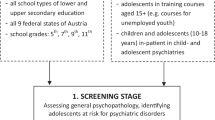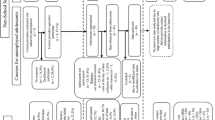Abstract
Half of mental disorders have their first onset before adulthood when the presence of a disorder may be particularly disruptive to developmental milestones. Retrospective prevalence estimates have been shown to underestimate the burden of mental illness and scarce data are available on the incidence of disorders throughout the adolescent period, especially in developing countries. Thus, the objective was to determine the incidence of mental disorders in an 8-year period from adolescence to young adulthood, onset of service use and their predictors in a Mexican cohort. 1071 respondents from a representative two-wave panel sample participated in the Mexican Adolescent Mental Health Survey in 2005 and in the follow-up survey in 2013. Disorders were evaluated with the World Mental Health Composite International Diagnostic Interview. 37.9 % experienced the onset of a psychiatric disorder and 28.4 % sought services for the first time. Substance use disorders had the greatest incidence, followed by mood and behavior disorders, anxiety disorders and lastly eating disorders. Sex, age, school dropout, childhood adversities and prior mental disorders predicted the onset of new disorders. Being female, having more educated parents and most classes of disorder predicted first time service use. These findings contribute to a paradigm shift in conceptions of mental disorder similar to how we think of common physical afflictions as near universal experiences across the life course, but less frequent at any given moment. Adolescents are particularly vulnerable. Therefore, public health policy should focus on early universal promotion of positive mental health and structural determinants of mental health.
Similar content being viewed by others
References
Kessler RC, Angermeyer M, Anthony JC et al (2007) Lifetime prevalence and age of onset distributions of mental disorders in the World Health Organization’s World Mental Health Surveys. World Psychiatry 6:168–176
Fergusson DM, Woodward LJ (2002) Mental health, educational and social role outcomes of adolescents with depression. Arch Gen Psychiatry 59:225–231. doi:10.1001/archpsyc.59.3.225
de Graaf R, ten Have M, Tuithof M, van Dorsselaer S (2013) First-incidence of DSM-IV mood, anxiety and substance use disorders and its determinants: results from the Netherlands Mental Health Survey and Incidence Study-2. J Affect Disord 149:100–107. doi:10.1016/j.jad.2013.01.009
Simon GE, VonKorff M (1995) Recall of psychiatric history in cross-sectional surveys: implications for epidemiologic research. Epidemiol Rev 17:211–227
Copeland WE, Shanahan L, Costello EJ, Angold A (2011) Cumulative prevalence of psychiatric disorders by young adulthood: a prospective cohort analysis from the Great Smoky Mountain Study. J Am Acad Child Adolesc Psychiatry 50:252–261. doi:10.1016/j.jaac.2010.12.014
Fergusson DM, Woodward LJ (2001) The christchurch health and development study: a review of findings on child and adolescent mental health. Aust N Z J Psychiatry 35:287–296
Patton GC, Coffey C, Romaniuk H, Mackinnon A, Carlin JB, Degenhardt L, Olsson CO, Moran P (2014) The prognosis of common mental disorders in adolescents; a 14-year prospective cohort study. Lancet 383:1404–1411. doi:10.1016/S0140-6736(13)62116-9
Wittchen HU, Lieb R, Pfister H, Schuster P (2000) The waxing and waning of mental disorders: evaluating the stability of syndromes of mental disorders in the population. Compr Psychiatry 41:122–132. doi:10.1016/S0010-440X(00)80018-8
Copeland WE, Shanahan L, Costello EJ, Angold A (2009) Which childhood and adolescent psychiatric disorders predictor which young adult disorders? Arch Gen Psychiatry 66:764–772. doi:10.1001/archgenpsychiatry.2009.85
Costello EJ, Mustillo S, Erkanli A, Keeler G, Angold A (2003) Prevalence and development of psychiatric disorders in childhood and adolescence. Arch Gen Psychiatry 60:837–844. doi:10.1001/archpsyc.60.8.837
Yu JW, Adams SH, Burns J, Brindis CD, Irwin CE (2008) Use of mental health counseling as adolescents become young adults. J Adolesc Health 43:268–276. doi:10.1016/j.jadohealth.2008.01.009
Oldehinkel AJ, Ormel J (2014) A longitudinal perspective on childhood adversities and onset risk of various psychiatric disorders. Eur Child Adolesc Psychiatry. doi:10.1007/s00787-014-0540-0
Kessler RC, Avenevoli S, McLaughlin KA, Greif Green J, Lakoma MD, Petukhova M, Pine DS, Sampson NA, Zaslavsky AM, Merikangas KR (2012) Lifetime comorbidity of DSM-IV disorders in the NCS-R Adolescent Supplement (NCS-A). Psychol Med 42:1997–2010. doi:10.1017/S0033291712000025
Benjet C, Borges G, Medina-Mora ME, Zambrano J, Aguilar-Gaxiola S (2009) Youth mental health in a populous city of the developing world: results from the Mexican Adolescent Mental Health Survey. J Child Psychol Psychiatry 50:386–395. doi:10.1111/j.1469-7610.2008.01962.x
Kessler RC, Üstün TB (2004) The World Mental Health (WMH) Survey Initiative Version of the World Health Organization (WHO) Composite International Diagnostic Interview (CIDI). Int J Methods Psychiatr Res 13:93–121. doi:10.1002/mpr.168
Kessler RC, Avenevoli S, Green J, Gruber MJ, Guyer M, He Y, Jin R, Kaufman J, Sampson NA, Zaslavsky AM (2009) National comorbidity survey replication adolescent supplement: III. Concordance of DSM.IV/CIDI diagnoses with clinical reassessments. J Am Acad Child Adolesc Psychiatry 48:386–399. doi:10.1097/CHI.0b013e31819a1cbc
Merikangas KR, Avenevolli S, Costello EJ, Koretz D, Kessler RC (2009) National comorbidity survey replication adolescent supplement: I. Background and measures. J Am Acad Child Adolesc Psychiatry 48:367–379. doi:10.1097/CHI.0b013e31819996f1
Haro JM, Arbabzadeh-Bouchez S, Brugha TS, de Girolamo G, Guyer ME, Jin R, Lepine JP, Mazzi F, Reneses B, Vilagut G, Sampson NA, Kessler RC (2006) Concordance of the composite international diagnostic interview version 3.0 (CIDI 3.0) with standardized clinical assessments in the WHO World Mental Health surveys. Int J Methods Psychiatr Res 15:167–180
Knauper B, Cannell CF, Schwarz N, Bruce ML, Kessler RC (1999) Improving the accuracy of major depression age of onset reports in the US National Comorbidity Survey. Int J Methods Psychiatr Res 8:39–48
Graubard BI, Korn EL (1999) Predictive margins with survey data. Biometrics 55:652–659
Bieler GS, Brown GG, Williams RL, Brogan DJ (2010) Estimating model-adjusted risks, risk differences, and risk ratios from complex survey data. Am J Epidemiol 171:618–623
Wolter K (1985) Introduction to variance estimation. Springer, New York
Eaton WW, Anthony JC, Tepper S, Dryman A (1992) Psychopathology and attrition in the epidemiologic catchment area surveys. Am J Epidemiol 135:1051–1059
de Graaf R, Bijl RV, Smit F, Ravelli A, Vollebergh WA (2000) Psychiatric and sociodemographic predictors of attrition in a longitudinal study: the Netherlands Mental Health Survey and Incidence Study (NEMESIS). Am J Epidemiol 52:1039–1047
Gustavson K, von Soestm R, Karevold E, Roysamb E (2012) Attrition and generalizability in longitudinal studies: findings from a 15-year population-based study and Monte Carlo simulation study. BMC Public Health 12:918. doi:10.1186/1471-2458-12-918
Medina-Mora ME, Borges G, Benjet C, Lara C, Berglund P (2007) Psychiatric disorders in Mexico: lifetime prevalence and risk factors in a nationally representative sample. Br J Psychiatry 190:521–528
Collishaw S, Maughan B, Goodman R, Pickles A (2004) Time trends in adolescent mental health. J Child Psychol Psychiatry 45:1350–1362
Costello EJ, Erkanli A, Angold A (2006) Is there an epidemic of child and adolescent depression? J Child Psychol Psychiatry 47:1263–1271
Sourander A, Koskelainen M, Niemelä S, Rihko M, Ristkari R, Lindroos J (2012) Changes in adolescents mental health and use of alcohol and tobacco: a 10-year time-trend study of Finnish adolescents. Eur Child Adolesc Psychiatry 21:665–671. doi:10.1007/s00787-012-0303-8
Moffitt TE, Caspi A, Taylor A, Kokaua J, Milne BJ, Polanczyk G, Poulton R (2010) How common are common mental disorders? Evidence that lifetime prevalence rates are doubled by prospective versus retrospective ascertainment. Psychol Med 40:899–909. doi:10.1017/S0033291709991036
Ormel J, Raven D, van Oort F, Hartman CA, Reijneveld SA, Veenstra R, Vollebergh WAM, Buitelaar J, Verhulst FC, Oldehinkel AJ (2014) Mental health in Dutch adolescents: a TRAILS report on prevalence, severity, age of onset, continuity and co-morbidity of DSM disorders. Psychol Med 45:260–345
Reidl Martinez LM, Gonzlez-Gonzalez A (2012) El contexto como la oferta de alcohol dirigía a jóvenes. In: Medina-Mora ME (ed) Alcohol y políticas públicas [Alcohol and Public Policy]. El Colegio Nacional, Mexico City, pp 101–140
Lange JE, Voas RB (2000) Youth escaping limits on drinking: binging in Mexico. Addiction 95:521–528
Seedat S, Scott KM, Angermeyer MC et al (2009) Cross-national associations between gender and mental disorders in the World Health Organization World Mental Health Surveys. Arch Gen Psychiatry 66:785–795. doi:10.1001/archgenpsychiatry.2009.36
Benjet C, Hernández-Montoya D, Borges G, Méndez E, Medina-Mora ME, Aguilar-Gaxiola S (2012) Youth who neither study nor work: mental health, education and employment. Salud Pública Mex 54:410–417
Breslau J, Miller E, Joanie Chung WJ, Schweitzer JB (2011) Childhood and adolescent onset psychiatric disorders, substance use, and failure to graduate high school on time. J Psychiatry Res 45:295–301. doi:10.1016/j.jpsychires.2010.06.014
Costello EJ, Copeland W, Angold A (2011) Trends in psychopathology across the adolescent years: what changes when children become adolescents and when adolescents become adults? J Child Psychol Psychiatry 52:1015–1025. doi:10.1111/j.1469-7610.2011.02446.x
Kessler RC, McLaughlin KA, Green JG et al (2010) Childhood adversities and adult psychopathology in the WHO World Mental Health Surveys. British J Psychiatry 197:378–385. doi:10.1192/bjp.bp.110.080499
Alexandre P (2008) Mental health care for youth: predictors of use are not always the same as predictors of volume. Soc Sci J 45:619–632. doi:10.1016/j.soscij.2008.09.004
Amone-P´Olak K, Ormel J, Oldehinkel AJ, Reijneveld SA, Verhulst FC, Buger H (2010) Socioeconomic position predicts specialty mental health service use independent of clinical severity: The TRAILS study. J Am Acad Child Adolesc Psychiatry 49:647–655
Clark J (2014) Medicalization of global health 2: the medicalization of global mental health. Global Health Action 7:24000. doi:10.3402/gha.v7.24000
IESM-OMS informe sobre el sistema de salud mental en México [IESM-WHO report on the mental Health system in Mexico] (2011). http://www.who.int/mental_health/who_aims_country_reports/who_aims_report_mexico_es.pdf. Accessed 19 January 2015
Acknowledgments
Wave I of the Mexican Adolescent Mental Health Survey was supported by the National Council on Science and Technology and Ministry of Education (Grant CONACYT-SEP-SSEDF-2003-CO1-22). Wave II was supported by the National Council on Science and Technology (Grant CB-2010-01-155221) with supplementary support from Fundación Azteca. The survey was carried out in conjunction with the World Health Organization World Mental Health (WMH) Survey Initiative. We thank the WMH staff for assistance with instrumentation, fieldwork, and data analysis.
Conflict of interest
On behalf of all authors, the corresponding author states that there is no conflict of interest.
Ethical Standards
This study was approved by the ethics committee of the National Institute of Psychiatry Ramón de la Fuente and therefore has been performed in accordance with the ethical standards laid down in the 1964 Declaration of Helsinki and its later amendments. At wave I, all participants were minors and thus gave their assent while their parents or legal guardians gave informed consent prior to their inclusion in the study. At wave II, all participants gave their informed consent.
Author information
Authors and Affiliations
Corresponding author
Rights and permissions
About this article
Cite this article
Benjet, C., Borges, G., Méndez, E. et al. Eight-year incidence of psychiatric disorders and service use from adolescence to early adulthood: longitudinal follow-up of the Mexican Adolescent Mental Health Survey. Eur Child Adolesc Psychiatry 25, 163–173 (2016). https://doi.org/10.1007/s00787-015-0721-5
Received:
Accepted:
Published:
Issue Date:
DOI: https://doi.org/10.1007/s00787-015-0721-5




